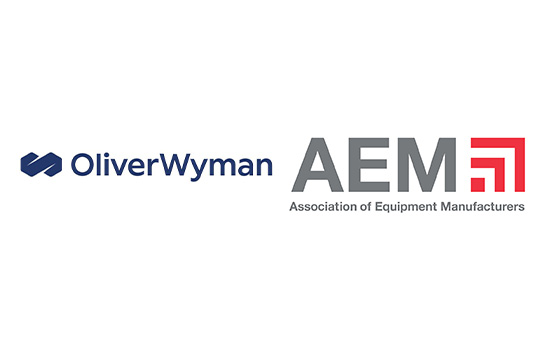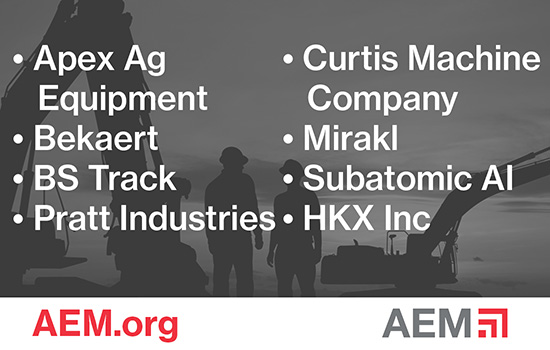By Gregg Wartgow, Special to AEM --
For agriculture industry stakeholders who’d like to see improvements in the area of sustainability, it is becoming clear that precision agriculture technology must play a prominent role. The beauty of this technology is that, to the typical farmer, it is also the key to becoming more productive, competitive, and profitable.
“Precision agriculture is the solution,” said AEM Senior Vice President Curt Blades, who’s responsible for the strategic direction of all agriculture programs and services for AEM members. “There is technology available today, as well as new technologies on the cusp of being released, that allow farmers to do so much more than they’ve ever been able to do, and with less.”
Blades was part of a virtual roundtable discussion hosted by AEM member company Topcon on Feb. 4. Several ag industry experts shared their thoughts on the state of precision agriculture, what the benefits of these technologies are, and how technology providers are taking steps to make sure these revolutionizing solutions are available to all types of farmers in all corners of the world.
Blades pointed to data found in AEM’s report, The Environmental Benefits of Precision Agriculture in the United States, to illustrate the technology’s potential to transform the industry.
“It’s easy to understand that a tractor driving across a field in a straight line will burn less fuel, which means it will produce fewer emissions,” Blades shared as an example. "Then you start talking about things like reduced overlap, and the more precise application of fertilizer and crop-protection inputs. The sustainability benefits grow exponentially with precision ag.”
Sustainability is everyone’s business. Whether it is through minimizing operational impact on the environment, aligning with ever-evolving regulations, or supporting a more sustainable world, the equipment manufacturing industry’s future depends on the responsible use of natural resources. Learn more at aem.org/sustainability.
Powering 21st Century Agriculture
Adoption of precision agriculture technologies has been climbing, particularly with respect to auto steer in developed countries like the U.S.
“We’re seeing up to an 80% adoption rate on certain crops and in certain parts of the country,” Blades said. “And the thing is, the maps and data a technology like auto steer helps generate are what often encourage a farmer to begin using additional precision technologies. The goal is a fully integrated precision agriculture system.”
One challenge the industry has faced is getting more of these technologies into the hands of more farmers. Availability and affordability have been barriers to adoption in many instances. Precision ag technology providers like Topcon are working to address that.
“The biggest request we hear across the globe is that farmers with a small tractor want the same technology that’s on a large tractor,” said Antonio Marzia, executive vice president and general manager of Topcon Agriculture. “To be honest, there is sometimes more technology on a tractor today than a car. That has helped grow volume for some of these technologies, which has helped manufacturers do more to optimize their designs and develop new solutions. This has created some momentum around the technology to help make it more available and affordable.”
As an example, Topcon recently introduced a new product, the Value Line Steering solution. It’s based on the company’s premium steering technology that has been around for decades on larger machines. Now, Value Line Steering is bringing that same technology to mid-range tractors found on smaller to mid-size farms.
The affordability piece is critical to seeing more widespread adoption.
“Precision agriculture is the solution. There is technology available today, as well as new technologies on the cusp of being released, that allow farmers to do so much more than they’ve ever been able to do, and with less.” -- AEM's Curt Blades
“Whether you’re a corporate farm, a mid-size farm, or a small farmer in a developing country, the number one thing is putting food on your table,” said Doug Schmuland, senior director, global OEM coordinator at Topcon Agriculture. “For companies like ours, it really boils down to the basics of providing solutions to what every farmer really needs.”
Auto steer has emerged as ag industry’s entry-level solution. Next is the ability to generate and record insightful data. Schmuland said farmers have been recording data for decades, only they’ve historically used a pen and notebook. The value of automating this process through precision ag technology is easy for the typical farmer to see.
“Now we’re at the point where even an entry-level farmer can record what he has just done in the field,” Schmuland said. “We’re starting to supply ag producers globally with tools to generate the data, and then the farmer can decide what they want to do with that data in their specific operation.”
Blades likened the proliferation of auto steer and other precision technologies to the power windows of a 1960s-era automobile. What started out as an optional feature on a luxury car eventually became standard on virtually every automobile manufactured.
“Now we’re starting to see that same kind of democratization of precision ag technologies,” Blades said. Sometimes it’s a precision technology that a farmer can retrofit onto existing equipment. Other times, it’s a brand-new piece of equipment with the technology built into it. Sometimes it’s a combination of the two. The bottom line is that the technologies are now more available than ever, and that is helping to drive adoption.
“This democratization creates the opportunity to really change agriculture globally as other regions of the world start to implement this technology to their own benefits,” Schmuland added. “It’s really an exciting time for agriculture. To see the look on a farmer’s face when their tractor drives straight … that’s a look of satisfaction you just can’t ignore.”
Driving Adoption in 2025 and Beyond
With the democratization of precision ag technologies comes the need for technology providers to make their solutions easier to use. As Marzia pointed out, a farmer often feels pressure from both regulators and consumers to be more sustainable. Since precision ag is an essential tool to help satisfy those demands, the technologies have to be easy for the typical farmer to implement.
The concept of machine interoperability is also important. According to Blades, different brands of farm equipment need to be able to “talk to each other” in the field in order for a fully integrated precision agriculture system to take shape. Blades expects to see some momentum in this area over the next three to five years. Interoperability is one of these basic solutions every farmer needs.
“Look at the computer and mobile device industries,” Blades said. “They’ve been able to take advantage of some major advancements, because everyone agreed on some really important protocols, such as Bluetooth and USB-C. Agriculture is moving in that same kind of direction using the ISOBUS standard, although we still have a ways to go. But when we can get to that widespread interoperability, we can really start seeing some unique solutions that farmers can take advantage of moving forward.”





